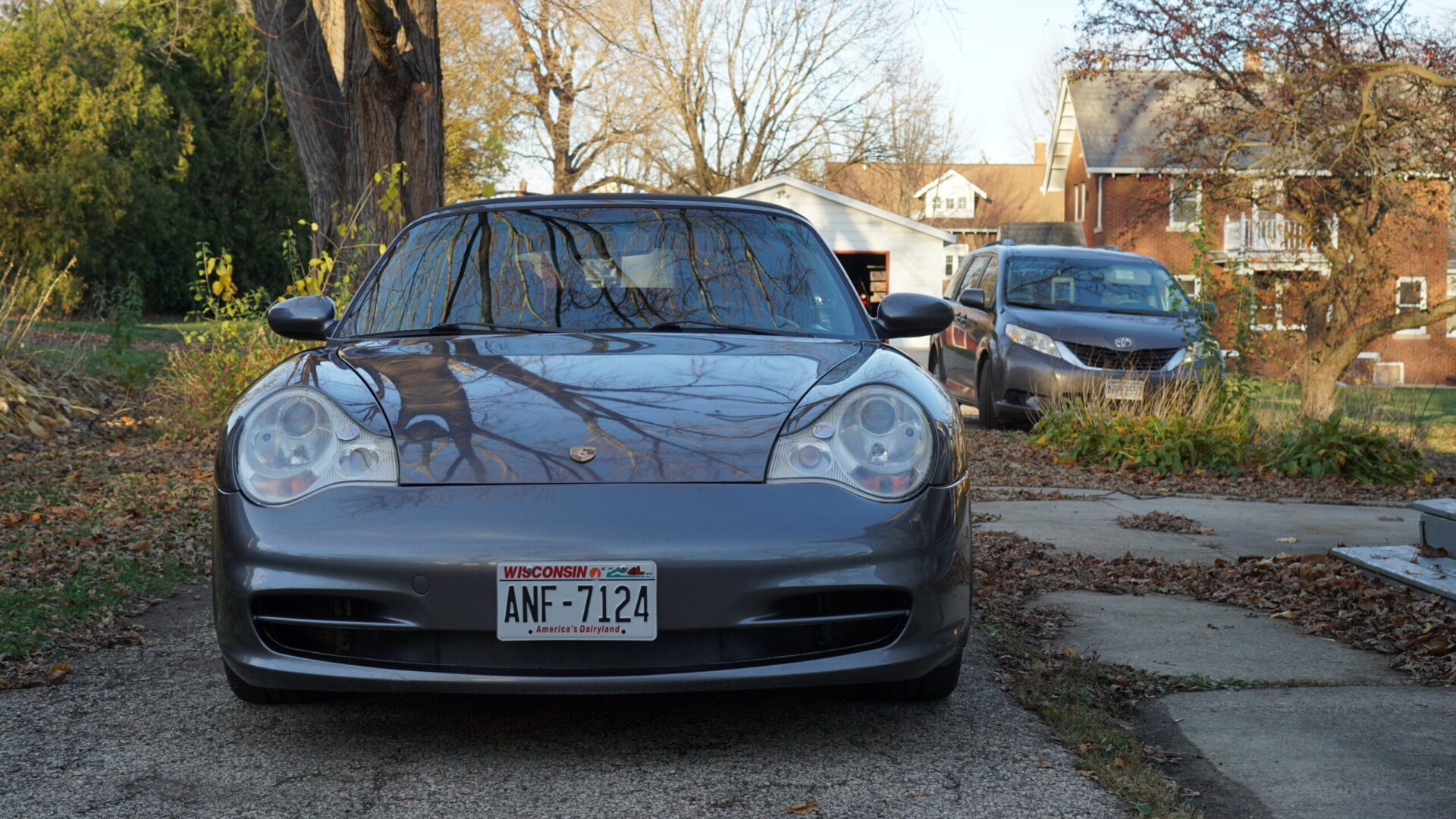In this post I’ll be going over mounting new tires and installing new shocks! My old tires were pretty dry rotted and were getting to the point that I didn’t feel comfortable running them at the speed limit. Which meant that I’d actually have to do the speed limit on back roads. That’s not going to fly, so I headed over to Amazon and picked up 4 new Kumho Solus KR21 tires in 185/75R14. I also used the bounce test and noticed that my shocks were beyond the point of being very useful, so I took advantage of a “buy 4, get $40 back” rebate that I came across on RockAuto to gift the Benz a new set of KYB gas-a-just shocks. Everything came in and it was time to get started!

I started with the tires as I needed to take the wheels off to get at the shocks, and I figured it would be a good way to get out of the sun for a bit. I pulled the front wheels and got started taking the tires off with our super awesome tire taker-offer™ machine.

The best way I’ve found to do this is to let a bit of air out of the tires so that you don’t have that fighting you while you’re trying to push the tires beyond the point where it mounts to the wheel. Once you get it loose you can take a tire pry bar and start getting the tire over the lip of the wheel.

I try to get the tire over the wheel in one spot and then take a second bar and work my way around the wheel. I also use a hammer to bring the tire over the lip by prying or hammering as needed. On steel wheels like these you don’t have to worry so much about accidentally hitting them with the hammer, so you can really work up a sweat! Eventually, you’ll get the tire off one side of the wheel. Then you just pull on the wheel and hammer the tire off the other side. It is also a good idea to note which side of the wheel is thicker, on my wheels the mount surface on the side facing in (when mounted on the car) has more surface area. You definitely want to pull the tire off the side with less surface area, it’ll put up less of a fight. Another thing to consider is the wheel size and profile. 14 wheels like these are fairly easy to work on. 17 inch wheels with lower profile tires? Once. Only once.

I also had a set of new valve stems, so I pulled the old ones through the wheel and tossed them out. I did have one of them rip off, which made it a bit more fun to get out. The stem pulling device is pretty cool, you twist the end on to the valve stem like a cap, and then pick a notch on the side and use it as leverage to pull the valve stem through.



I thought that it would be best to knock the old wheel weights off and clean the wheels up a bit before going any further. So I broke out the dust mask, drill, and the wire wheel and got to making some nasty stuff you don’t want to breath.


Once everything was cleaned up, I grabbed the new valve stems and some tire sealant and ran a little sealant in the groove that the new stems would sit in. I didn’t want to deal with leaky valve stems as they aren’t nearly as easy to fix as leaky tires. Naturally, I didn’t use sealant when mounting the tires on the wheels and was rewarded with a slow leak on one of the rear wheels. I just took it off, used our super awesome tire taker-offer™ machine to break the bead all the way around, and ran some sealant on the lip before pumping the tire back up. It is also worth noting that you should do both the inside and outside bead while you’ve got the tire off, I got burned on the Mazda once as I assumed it was leaking on the outside lip. I got to take everything back apart a few days later to seal up the inside lip.


Getting the tires to seal up enough to fill with air can be a bit tricky. This may be easier with tire sealant as it can help stop the air from leaking around the lip on either side. It can take some maneuvering, but you’ll get it filling eventually.
On to the shocks! I started with the front shocks because that’s how I roll. It’s a pretty straight forward process, you just look around and figure out what is attached where, and make it not attached. I actually did have a bit of fun finding the top bolts as they are buried under some other stuff on both sides.



There are a total of 3 bolts holding the shocks on, so it’s pretty easy to find and remove them. Reversing the process is also fairly simple. Naturally, the new shocks are much stronger than the old shocks that you can probably compress by hand, so it pays to line them up carefully before pulling the strap off and letting the new shock expand into it’s new home. They aren’t impossible to compress, but it’s quite a workout to compress, line up, and get the nuts started simultaneously. Once everything is tightened up you can toss the wheels back on and let the car down to admire your handiwork.

The rear shocks are designed a bit differently, such that they would drop out of the bottom of the control arm rather than wiggle out the middle. I had to scratch my head on that for a second, but re-positioning the jack to move the control arm up I was able to get the shock out and find a home for the new one.

I also had an issue with the rear shocks where tightening the nut on the top bolt would spin the upper shock housing. On the front I was able to simple hold the upper shock housing while I tightened the nut, but the rear shock is mounted up in the trunk. To remedy this, I used a vice grip that was on just hard enough to keep the shock in place while I tightened things up. The new hardware is so shiny, It’s kind of funny next to all the rust.



Unfortunately, I was using an impact wrench to loosen the nut for each of the bottom shock mounts. When removing rusted bolts or nuts, you should really use some lubricant and let it sit before you try moving it. So if you plan a few days ahead and douse the rusty bits every day you should have a considerably easier time removing rusty stuff. This also helps avoid shearing a bolt or breaking a bolt head off, and is definitely the correct way to do things. Naturally, I did things the wrong way, and ended up breaking the very last bolt I needed to get out. As a result, I got to experience the fun of drilling a bolt out.
I started by using a punch to make an indent in the center of the bolt. This would act as a guide for the drill and make sure I didn’t mess up the thread that the bolt followed. That kind of worked.

With a sort of guide I grabbed some drill bits made for metal and started dropping hot little curly metal pieces on my face as I drilled. I started small and worked up a few sizes at a time. Eventually, I got far enough to try an “easy-out” which is basically a reverse threaded bit that you hand turn in to the hole you drilled. In theory, this will bite in to the hole and allow you to turn the bolt out and preserve the original thread for re-use. That didn’t really work out, so I just drilled out all the old bolt material and grabbed a new bolt and nut from the garage. It worked just as well after I tightened it down, but I’d definitely recommend skipping the whole “break a bolt and drill it out” experience.


And that’s all there is to it, new shocks all the way around and tires that (after being balanced at a local shop) are road ready. Minus the drilling, everything went pretty smoothly and was a nice way to spend a few hours of my weekend.
In my next post I’ll be going over my brush with the distributor, swapping out the starter, and the beginning of the dreaded carburetor rebuild. I’m still working on getting those things worked out. See you then!

